Nikon AF-S 24-70mm f/2.8G ED NIKKOR
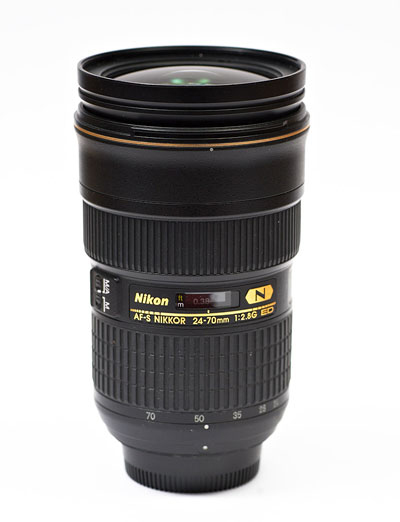 |  ePHOTOzine lens tester, Gary Wolstenholme tests the Nikon AF-S 24-70mm f/2.8G ED lens in a variety of situations. Is it worth the £1200 price tag and will Gary give it back to Nikon voluntarily. |
Covering a wider angle than Nikon's previous standard f/2.8 constant aperture standard zooms, the 24-70mm is a very versatile professional quality optic. As with their other updated pro lenses, the 24-70mm sports a raft of features including internal focusing, a Silent Wave motor for quick and virtually silent focusing with full time manual override, ED glass to reduce chromatic aberrations and Nano crystal coating which promise to make the lens more resistant to ghosting and flare.
Nikon AF-S 24-70mm f/2.8G ED NIKKOR: Features and handling
This new lens feels smaller and lighter than its predecessor, but it is big. Despite its size, it balances perfectly on my D700 with or without the MB-D10 grip attached. A large hood is supplied which attaches to the body of the lens allowing the front element to move back and forth inside the hood depending on the focal length selected. The lens is longest at the 24mm setting getting shorter towards 50mm and then a little longer again at 70mm. The zoom barrel is nice and easy to rotate, only needing a light touch to set it in motion. On my review sample the mechanism is nice and smooth between 24mm and 50mm but seems to grind a little at longer focal lengths. This could be a quirk of this particular model though.
Focus is performed internally, so the front element does not rotate at all. The Silent Wave motor ensures focus is achieved lightening quick, and accurately to boot. The lens had no trouble keeping up with erratic subjects when mounted on a D700.
Metal is used for the majority of the construction and so the lens feels reassuringly solid and well put together. In fact I'd go as far as to say it has been a pleasure using this lens due to the handling and its performance.
Nikon AF-S 24-70mm f/2.8G ED NIKKOR: Performance
For this review, the lens was tested on a 12Mp Nikon D700 using Imatest.
Throughout the zoom range the 24-70mm produces good resolution in the image centre with the corners being less sharp, but acceptable for most applications. Stopping down to f/4 produces a massive increase in resolution in the centre resolution at the wider focal lengths. This lens is very, very sharp in the centre. The resolution at the edges of the image area continue to improve at these shorter focal lengths until around f/11, where the lens gives the most even resolution across the image area.
At 70mm, clarity becomes more uniform across the image area, and the resolution f/2.8 actually improves a little. Selecting f/4 still gives the highest resolution in the centre, just as with shorter focal lengths. Overall, it's quite impressive, even with the corners lagging behind the centre resolution somewhat. This lens delivers images with real bite to them, probably partially down to the excellent contrast produced by this optic, which helps with the appearance of sharpness.
| Resolution at 24mm |
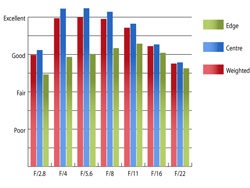 |
| Resolution at 35mm |
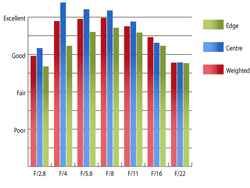 |
| Resolution at 70mm |
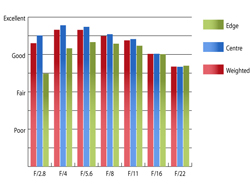 |
Chromatic Aberrations are well controlled covering a shade over 0.75 pixel-widths at their worst, towards the edges of the image area, which is at 35mm and f/2.8. This will not cause any issues for most as you'd really have to go looking for them to find any sign of them in a normal image taking scenario. At 70mm, Chromatic Aberration is so well controlled it's barely worth worrying about.
| Chromatic Aberrations at 24mm |
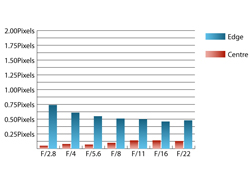 |
| Chromatic Aberrations at 35mm |
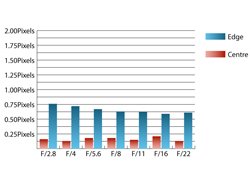 |
| Chromatic Aberrations at 70mm |
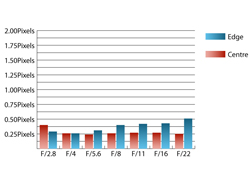 |
As with other large aperture zooms light falloff is present, but on this lens it's not too much of an issue. At 24mm and f/2.8 the corners are 1.6 stops darker than the image centre, stopping down improves uniformity, and by f/5.6 the falloff has almost completely disappeared. Vignetting is around the same throughout the zoom range, with the corners being 1.7 stops darker than the image centre at 70mm.
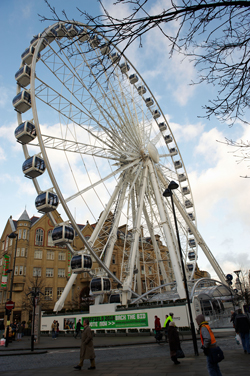 Nikon AF-S 24-70mm at 24mm. | 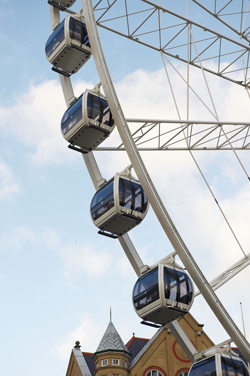 Nikon AF-S 24-70mm at 70mm. |
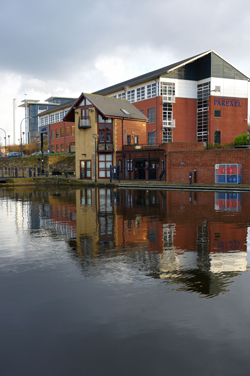 |  The 24-70mm focal length range is really useful, indoors and out. |
Imatest recorded 4.45% barrel distortion at 24mm, which will be noticeable in straight lines such as architecture. This amount of barrel distortion can easily be corrected and will not be overly disturbing most of the time. Setting 70mm produces 0.77% pincushion distortion, which will be difficult to notice, even with straight lines present.
Very little flare or ghosting is present with strong light sources in the frame, or just outside the image area. Nikon's Nano-Crystal coating seems to do exactly as promised with only a very slight loss of contrast and flare at maximum aperture.
 | DxOMark provides objective, independent, RAW-based image quality performance data for lenses and digital cameras to help you select the best equipment to meet your photographic needs. Visit the DxOMark website for tests performed on the Nikon AF-S 24-70mm f/2.8G ED NIKKOR. |
Nikon AF-S 24-70mm f/2.8G ED NIKKOR: Verdict
Although not very exotic, the standard zoom covers a range most photographers couldn't do without. The Nikon 24-70mm performs as you would expect from a lens of this calibre and price. Build quality is excellent, the focusing is fast and most importantly the images are sharp and contrasty in a range of conditions and will find its way into many photographer's kit bags as a result, despite the £1200 plus price tag. Although there are cheaper alternatives available, they will rarely deliver the quality this lens does. As a result, it will be good value to you if you're unwilling to compromise on quality.

| FEATURES |  |
| HANDLING |  |
| PERFORMANCE |  |
| VALUE |  |
| OVERALL |  |
Nikon AF-S 24-70mm f/2.8G ED NIKKOR: Pros
 Excellent central resolution throughout the focal length range
Excellent central resolution throughout the focal length range Great contrast
Great contrast Superb resistance to flare and ghosting
Superb resistance to flare and ghostingNikon AF-S 24-70mm f/2.8G ED NIKKOR: Cons
 Corner quality could be better
Corner quality could be better Rough zoom mechanism on this sample
Rough zoom mechanism on this sample Size – it is a long lens
Size – it is a long lens Nikon AF-S 24-70mm f/2.8G ED NIKKOR: Specification
| Price | £1185 |
| Contact | Nikon UK Ltd |
| Filter size | 77mm |
| Format | FX/35mm |
| Construction | 15 elements in 11 groups |
| Angle-of-view | 84° - 34°20' (61° - 22°50' with DX format camera) |
| 35mm equivalent focal length | 24-70mm (36-105mm on APS-C body) |
| Internal focusing | Yes |
| Image stabilisation | No |
| Minimum focus distance | 38cm |
| Maximum aperture | f/2.8 |
| Minimum aperture | f/22 |
| Weight | 900g |
| Size | 133x83mm |
| In the box | Soft case, lens hood |
Add your message
Login required
Please login here or if you've not registered, you can register here. Registering is safe, quick and free.
Please login here or if you've not registered, you can register here. Registering is safe, quick and free.
photodo Stats
1102 lenses
428 MTF tests
74 in-depth photodo reviews
100+ users join each day
Help the lens community by reviewing or rating a lens today via our lens search
428 MTF tests
74 in-depth photodo reviews
100+ users join each day
Help the lens community by reviewing or rating a lens today via our lens search
Latest Lens Reviews
- Chinon 28mm f/2.8 Vintage Lens Review
- Canon EF 70-200mm f/4L IS II USM Lens Review
- Samyang AF 85mm f/1.4 EF Review
- Sigma 70mm f/2.8 DG Macro Art Review
- Samyang AF 24mm f/2.8 FE Review
- Meike 50mm f/1.7 Review
- Tamron 70-210mm f/4 Di VC USD Review
- Lensbaby Burnside 35mm f/2.8 Review
- Asahi Super Takumar 50mm f/1.4 Review
- Asahi Super-Multi-Coated Takumar 135mm f/3.5 Review
